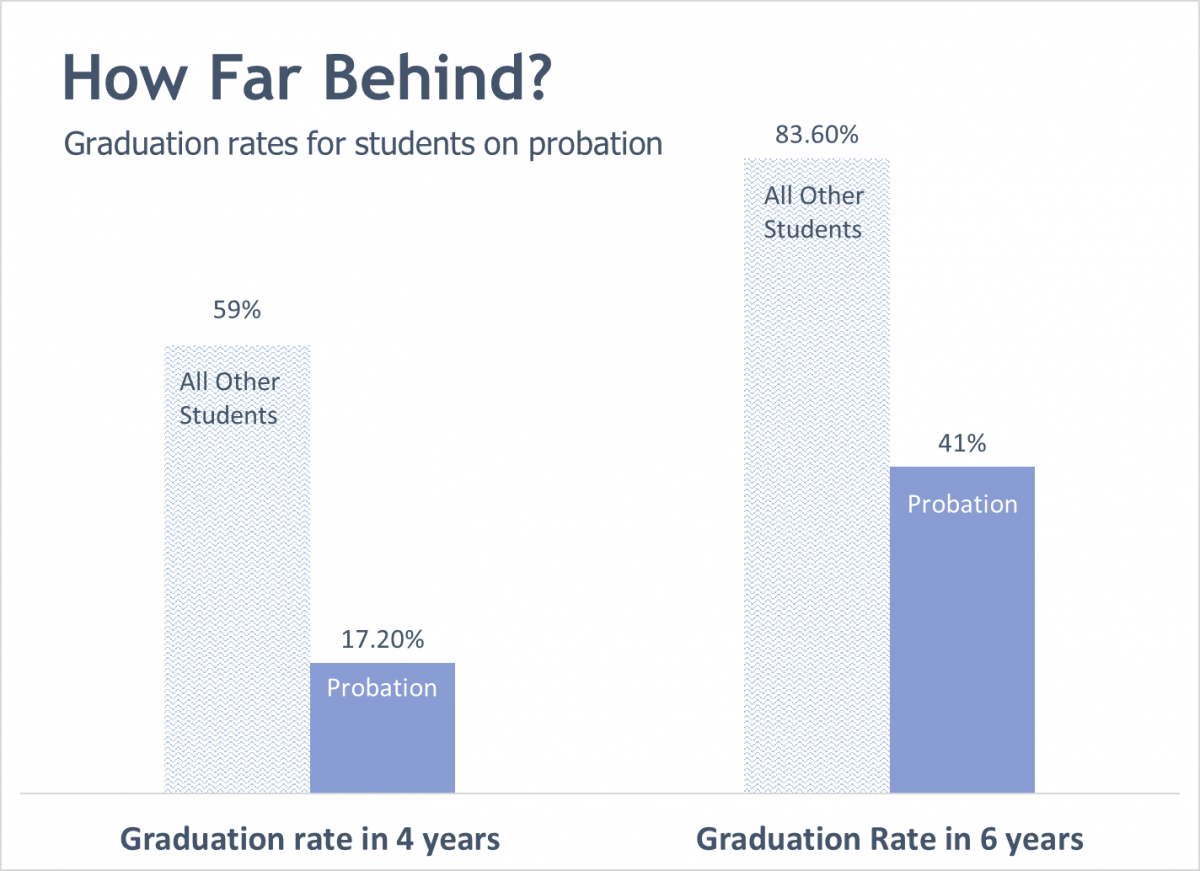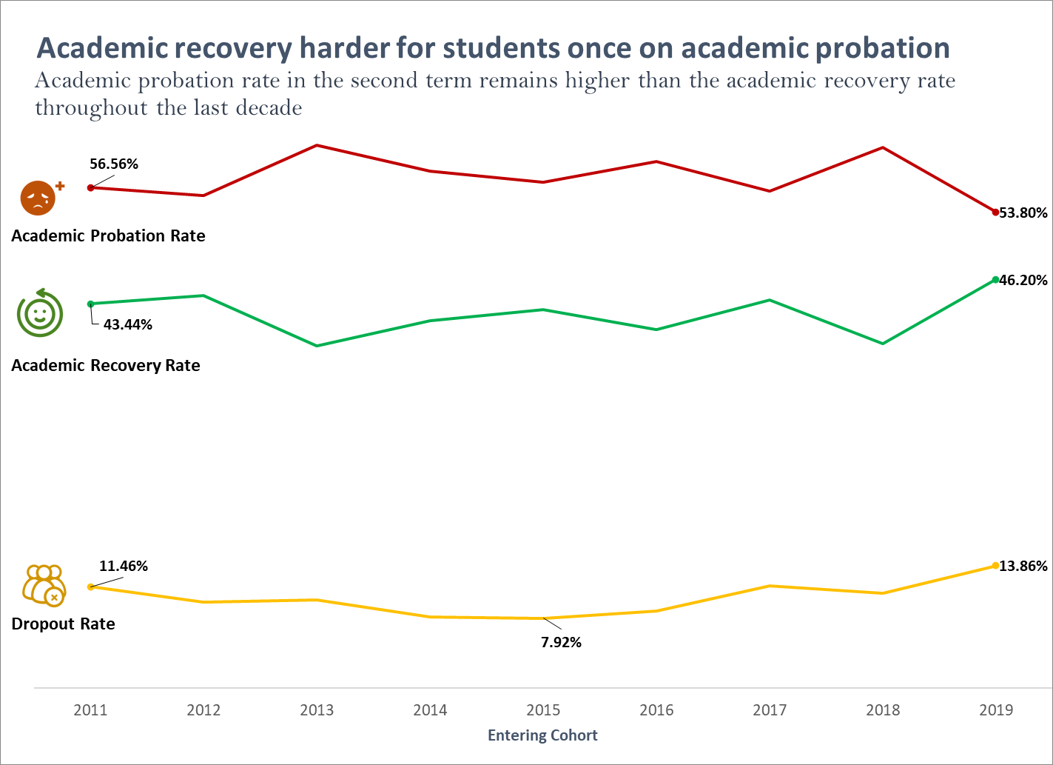Across the globe, there has been a constant push for students to obtain higher education. With an increasingly higher demand for technical and soft skills by employers and a high wage premium associated with higher education, more and more students opt to attend post-secondary education even when they are not college prepared. Only one-third of high school graduates in 4-year colleges are unprepared with the skills necessary to be successful in college, according to a report by Complete College America. That is, one-third of students entering college require at least one year of remedial coursework in English, math, or both.
But what does academic success even mean? And what factors lead to academic success? This is important to understand because as we are progressing towards higher goals of expanding post-secondary attainment, it is vital to look back and see if we are leaving some people behind.
The gap between high school graduation requirements and college readiness standards can leave some students unprepared for the academic rigor demanded in college. In 2015, for example, 37% and 38% of high school seniors scored at the basic and below basic levels in mathematics, respectively on the National Assessment of Educational Progress. Students scored similarly at reading skills. Academically falling behind one’s peers can have a huge effect on a student’s mental health, financial stability, and self-confidence. According to a report by the Center for American Progress, remedial courses cost students and their families approximately $1.3 billion across the 50 states and the District of Columbia annually. Taking extra coursework can increase students’ time to degree attainment. This can lead to students dropping out or failing to graduate, leaving them burdened with student debt but no degree.
Students who drop out of college face even a greater challenge of entering workforce or transferring to other educational institutions. The increase in earnings for college dropouts are fairly modest as compared to the high wage premium associated with college graduates. Thus, we can see that retention efforts for academically struggling students benefit not only the individual but also the institution, community, and economy at large.
To address this issue, all major universities use academic probation as a tool to act as a warning signal for under-performing students. Typically, students who achieve a grade point average GPA of 2.0 or less on a 4.0 scale are put on academic probation. Students put on a probationary status are given a semester or two depending on their school to improve their academic standing by making evident progress as per their school’s eligibility criteria. Once on probation, students typically are required to attend monthly meetings with their academic advisor, develop a success plan, undertake mandatory courses, and pass a specified number of credits. Students failing to return to good academic standing can especially be vulnerable to higher risk of academic failure and dismissal from the university. Depending on one’s school, probation programs can be more restrictive or supportive in nature.
Academic probation can be a significant factor in determining a student’s future outcomes, vital not only for one’s standing in a university but also for future employment purposes. Hence understanding the extent of the problem and its differential impact on specific student populations can help universities to target intervention programs to assist students struggling in stressful college environment.
For my capstone project, which was the final practical component as part of my graduate studies, I worked with a data set of 85,000 undergraduate students enrolled at MSU in the period 2010 to 2019 that included students from varying backgrounds, ethnicities, and origins to understand whether the university’s primary tool to assist students is effective. Through my data, I sought to identify a demographic profile of students on academic probation, discern factors affecting probation and academic recovery and analyze its impact on graduation and persistence.
I find that the policy in its current form is ineffective, especially for students from socio-economically disadvantaged backgrounds. I define students from disadvantaged backgrounds as those who come from the lowest socio-economic bracket and hence are disadvantaged as compared to their peers. Only, 40.5%  of students on probation in the first term graduate in 6 years as opposed to the university average graduation rate of 84%. Additionally, 38% of students on probation in the first term end up dropping out prior to the second year as compared to 6% of students who drop out generally.
of students on probation in the first term graduate in 6 years as opposed to the university average graduation rate of 84%. Additionally, 38% of students on probation in the first term end up dropping out prior to the second year as compared to 6% of students who drop out generally.
First generation students, students receiving Pell grants and those from under-represented minorities are at greater risk of not only being on academic probation, but also of dropping out and failing to graduate in six years.  While the likelihood of graduation for students on probation decreases consistently across the board, students from disadvantaged groups are hit the hardest.
While the likelihood of graduation for students on probation decreases consistently across the board, students from disadvantaged groups are hit the hardest.
Once a student ends up on academic probation, it becomes harder for them to recover On average, 58% of students on academic probation in the first term fail to academically recover in the next term. Of those who do not recover, African Americans & Hispanic/Latinx student populations disproportionately constitute the major proportion. Thus instead of aiding students to perform academically better, academic probation acts as a “systemic black hole” difficult to emerge from.
 To gain a comprehensive understanding of academic probation policy at MSU and how it impacts student populations, I also interviewed some members of the faculty support staff. One MSU higher education specialist explained that “there is no university-wide central policy when it comes to probation,” as the policy of academic probation is inconsistent among different colleges on campus. An academic advisor added that “sometimes there are as many as 1000 students per advisor, so there is no personal connection for students.” Lack of personal attention can further distant students from academic engagement and prevent them from receiving the guidance they actually need, which can especially be critical for low-income students. With academic probation at MSU failing from supporting students as envisioned, she concluded that “the whole system needs to be reformed. All pieces of the puzzle need to be looked at together.”
To gain a comprehensive understanding of academic probation policy at MSU and how it impacts student populations, I also interviewed some members of the faculty support staff. One MSU higher education specialist explained that “there is no university-wide central policy when it comes to probation,” as the policy of academic probation is inconsistent among different colleges on campus. An academic advisor added that “sometimes there are as many as 1000 students per advisor, so there is no personal connection for students.” Lack of personal attention can further distant students from academic engagement and prevent them from receiving the guidance they actually need, which can especially be critical for low-income students. With academic probation at MSU failing from supporting students as envisioned, she concluded that “the whole system needs to be reformed. All pieces of the puzzle need to be looked at together.”
Based on those interviews and my research, I make broad recommendations for a policy reform that include establishment of a cohesive university-wide policy for probation, a more student-centric approach and utilization of non-cognitive indicators to measure student success which is currently lacking. The problem of preparedness and the traditional approach to address it through academic probation is not just limited to MSU but is prevalent across all universities. By reforming the current policy, MSU can lead the way for others to follow.
Currently academic probation is viewed as a required administrative measure, however there is a need to look beyond probation and transform it into more of proactive support mechanism for students. It is essential that universities provide quality academic experience for students from diverse populations and bring access and success for ALL. Higher education provides a promise of opportunity for students from low socio-economic strata to break barriers and move up the economic ladder. However, if our current policies fail to assist these students, higher education may end up reinforcing the present economic differences and even worse, enlarging them.
With deep appreciation for guidance from Joshua Sapotichne, associate professor of political science, and Erika Rosebrook, assistant professor of political science, and with special thanks to Susan Richter, data scientist at Michigan State University’s Office of Planning and Budgets, for personally supervising my research.
Many thanks to IPPSR Director Matt Grossmann and Associate IPPSR Director Arnold Weinfeld for the opportunity to study with them as an IPPSR Graduate Fellow at MSU’s Institute for Public Policy and Social Research.



